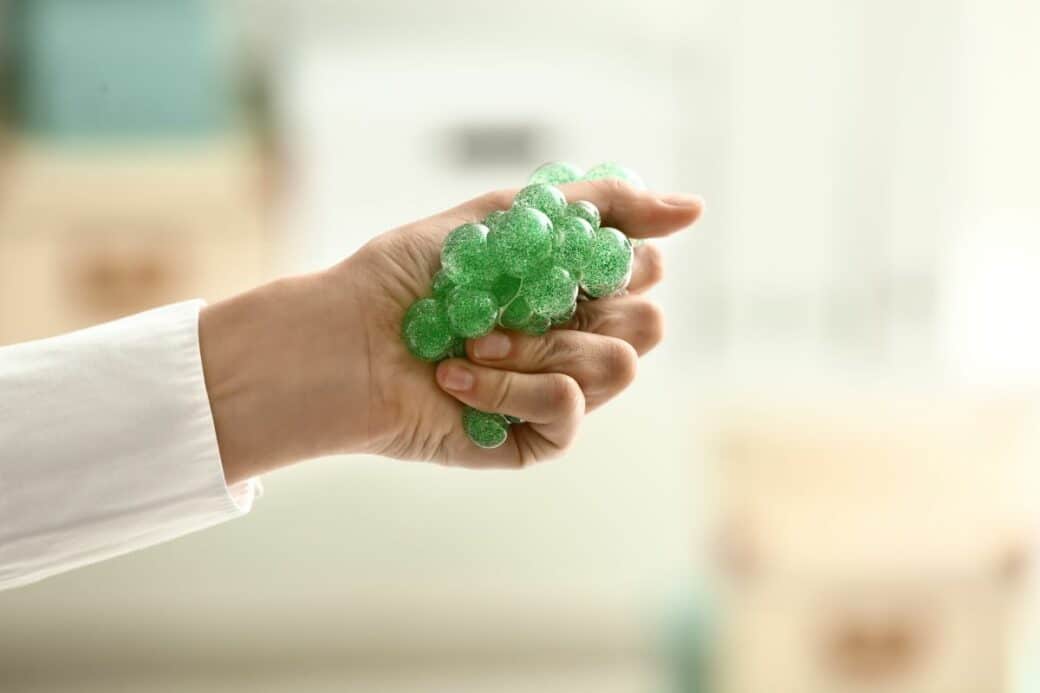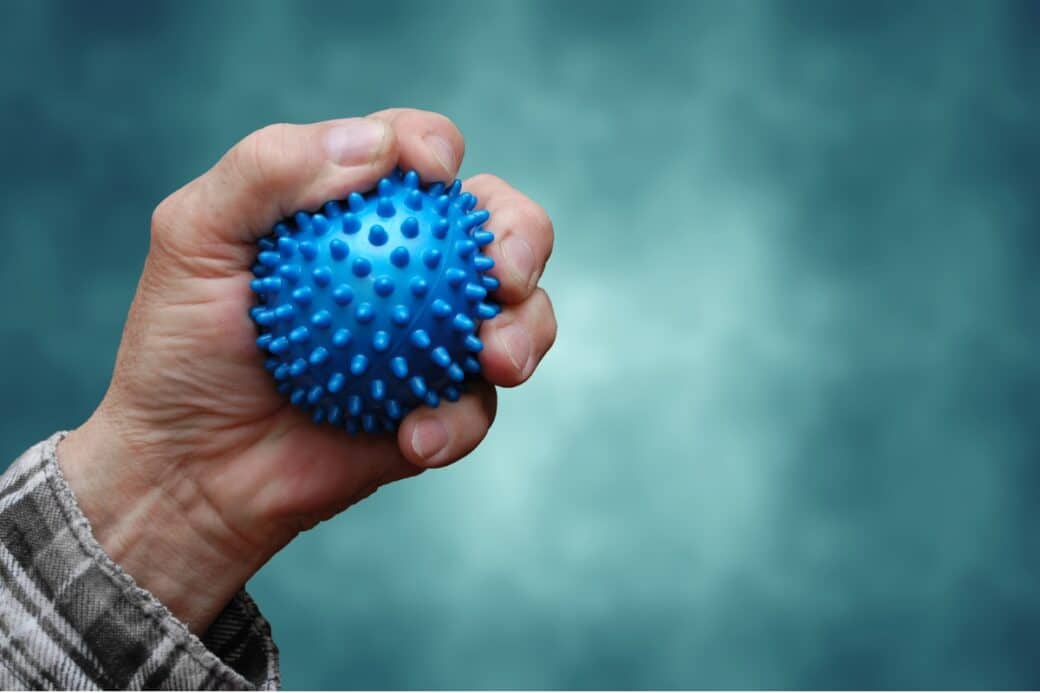Are you curious about what exactly stress balls are made of? The answer may surprise you! These compact and squishy toys are commonly used to relieve stress and tension, but have you ever wondered what materials make them so effective? In this article, we will uncover the secret behind stress balls and explore the various materials that go into making them. Prepare to be enlightened as we delve into the fascinating world of stress ball composition!

What Are Stress Balls Made Of: History of Stress Balls
Origin of stress balls
The history of stress balls dates back to ancient times. The concept of squeezing an object to relieve stress can be traced back to China, where Baoding balls, also known as Chinese meditation balls, were used as a form of exercise and stress relief. These balls, made of metal, were designed to be rotated in the palm of the hand, promoting relaxation and improving hand coordination.
Use of stress balls in ancient cultures
Stress balls have been utilized in various ancient cultures for their therapeutic benefits. In ancient Greece and Rome, people used smooth stones or clay balls as stress-relieving tools. These balls were not only effective in reducing tension but also served as a form of entertainment. Similar to Baoding balls, they were squeezed and rolled in the palm of the hand.
Modern adaptation and use of stress balls
In modern times, stress balls have become indispensable tools for stress relief and relaxation. They have evolved from simple stones to a wide variety of shapes, sizes, and materials. The modern stress ball is typically made from a soft, pliable material filled with gel, foam, or other pressure-sensitive substances. These adaptations allow for a more customizable and effective stress-relieving experience.
The Science Behind Stress Relief

How stress affects the human body
Stress not only impacts our mental state but also manifests physically in our bodies. When we experience stress, the body releases hormones such as cortisol and adrenaline, triggering the body’s fight-or-flight response. This response causes increased heart rate, elevated blood pressure, muscle tension, and shallow breathing, leading to feelings of anxiety and discomfort.
The role of tactile stimulation in stress relief
Tactile stimulation, such as squeezing a stress ball, has been proven to significantly reduce stress levels. When you squeeze a stress ball, the muscles in your hand and forearm contract, which increases blood flow and releases tension. This physical action triggers a relaxation response in the body, leading to a decrease in stress hormones and an overall sense of calm.
Understanding the mind-body connection
The mind-body connection plays a crucial role in stress relief. By engaging in physical activities such as squeezing a stress ball, you redirect your focus from stress-inducing thoughts to the present moment and the sensations in your body. This shift in attention allows for a break from negative thinking patterns and promotes a more relaxed state of mind.
Different Kinds of Stress Balls
Types based on materials used
Stress balls come in a variety of materials to suit different preferences and needs. Some common materials used for stress balls include foam, gel, and rubber. Foam stress balls are lightweight and soft, making them comfortable to squeeze for extended periods. Gel stress balls provide a more tactile and firm resistance, giving a satisfying feeling when squeezed. Rubber stress balls offer durability and bounce-back abilities, making them perfect for those who prefer a more resilient stress-relief experience.
Types based on level of resistance
Stress balls are also available in different resistance levels. Some individuals may prefer a stress ball with low resistance, allowing for gentle and easy squeezing. These stress balls are ideal for individuals with weaker hand muscles or those recovering from hand injuries. On the other hand, high-resistance stress balls provide a greater challenge and are suitable for individuals with stronger grip strength or those seeking a more intense stress-relieving workout.
Types based on shapes and sizes
Stress balls come in various shapes and sizes to cater to individual preferences. From traditional spherical stress balls to fun-shaped ones like animals, fruits, or sports equipment, there’s a stress ball for everyone. Some stress balls are even designed to target specific muscle groups, such as finger and thumb exercisers. The diverse range of shapes and sizes allows for personalized stress relief and adds an element of fun to the experience.
Key Components of a Stress Ball
Basic structure and components
A typical stress ball consists of two main components: the outer cover and the filling. The outer cover is usually made of a soft, flexible material that provides the desired texture and resistance. The filling, which is placed inside the cover, determines the firmness and feel of the stress ball.
The role of each component
The outer cover of a stress ball serves as a protective layer, ensuring durability and resistance to external factors. It also provides the necessary texture for a tactile and comfortable grip. The filling inside the stress ball is responsible for the desired resistance and feel when squeezed, allowing for effective stress relief.
How components contribute to stress relief
The combination of the outer cover and filling of a stress ball plays a crucial role in stress relief. The outer cover provides the necessary resistance and texture, while the filling material determines the firmness and bounce-back ability. The interaction between these components creates a physical sensation that promotes relaxation and reduces stress.
Examining the Outer Cover of Stress Balls
Common materials used for outer cover
Stress balls can be covered with various materials to cater to different preferences. Some common materials used for the outer cover include thermoplastic elastomers (TPE), polyurethane (PU) foam, and silicone. TPE offers a soft and rubber-like texture, providing a comfortable grip. PU foam provides a slightly textured yet flexible surface for a satisfying squeeze. Silicone is known for its hypoallergenic properties and can offer a smooth or textured grip, depending on the design.
Role of the cover in providing resistance and durability
The outer cover of a stress ball determines its resistance level and durability. The material used for the cover should have enough elasticity to withstand repeated squeezing without losing shape or tearing. The cover’s texture also contributes to the resistance felt when squeezing the stress ball, allowing for effective muscle engagement and stress relief.
How the texture of the outer cover affects its stress-relieving properties
The texture of the outer cover greatly influences the stress-relieving properties of a stress ball. A smooth-textured cover provides a gentle and calming sensation, making it suitable for relaxation purposes. On the other hand, a textured cover provides tactile stimulation and a firmer grip, allowing for a more intense stress-relieving experience. The texture of the outer cover can be customized to cater to individual preferences and specific stress relief needs.
Understanding the Filling of Stress Balls
Common fillings used in stress balls
Stress balls can be filled with various materials to achieve different levels of resistance and flexibility. Common fillings include gel, foam, and rice. Gel-filled stress balls offer a pliable and firm resistance, providing a satisfying squeeze. Foam-filled stress balls offer a softer resistance and are lightweight, making them ideal for prolonged use. Rice-filled stress balls provide a malleable and moldable feel, allowing for customized support and pressure.
Function of pressure-sensitive fillings
Pressure-sensitive fillings in stress balls respond to the applied force by deforming and exerting an equal amount of pressure back. This characteristic allows the stress ball to provide a consistent resistance to the hand muscles. By adjusting the grip and strength of the squeeze, individuals can control the level of pressure and customize their stress-relief experience accordingly.
How the filling material impacts the resistance and feel of the stress ball
The filling material of a stress ball determines its resistance and overall feel. Gel-filled stress balls offer a firmer resistance and a more substantial feel when squeezed. Foam-filled stress balls provide a softer and more cushioned feel, making them comfortable for extended use. Rice-filled stress balls offer a unique texture and can be manipulated to provide targeted pressure on specific areas, offering a customizable stress-relieving experience.
The Manufacturing Process of Stress Balls
Step-by-step process of making a stress ball
The manufacturing process of stress balls involves several steps to ensure a high-quality product. Firstly, the outer cover material is selected and shaped using specialized molds or machinery. The cover is then sealed and filled with the desired filling material. After the stress ball is filled, it undergoes a quality control check to ensure proper shape, resistance, and durability. Finally, the stress balls are packaged and prepared for distribution.
Special considerations for adding designs and colours
To make stress balls more visually appealing and personalized, manufacturers often add designs and colors. This can be done by incorporating pigments or dyes into the outer cover material during the production process. Specialized printing techniques may also be used to add intricate designs or logos to the stress balls. These design elements not only enhance the aesthetic appeal but also allow individuals to choose stress balls that resonate with their preferences.
Quality control and safety standards in the manufacturing process
During the manufacturing process, stress ball manufacturers adhere to strict quality control and safety standards. This ensures that the stress balls meet specific criteria for durability, resistance, and safety. Manufacturers may conduct rigorous testing to evaluate factors such as material strength, fill leakage, and overall product performance. Compliance with safety standards guarantees that stress balls are safe for use and free from harmful substances.
DIY Stress Balls
Materials and preparatory steps
Making your own stress ball is a fun and creative activity. To create a DIY stress ball, you will need materials such as balloons, flour or rice, a funnel, and optional decorative items like markers or stickers. Preparatory steps involve gathering all the necessary materials, setting up a clean workspace, and inflating the balloon partially.
Detailed guide to making your own stress ball
To make a DIY stress ball, follow these steps:
- Stretch the balloon by repeatedly inflating and deflating it to increase its flexibility.
- Attach the funnel to the opening of the balloon.
- Pour flour or rice into the funnel, allowing it to slowly fill the balloon.
- Adjust the amount of filling based on the desired level of resistance and firmness.
- Once the balloon is filled, tie a knot at the opening to seal it.
- Optionally, decorate the stress ball using markers or stickers to add a personal touch.
Ideas for customization and personalization
Customizing your DIY stress ball allows you to make it unique and tailored to your preferences. You can use different colored balloons, add patterns or designs using markers or stickers, or even personalize it by writing positive affirmations. Personalizing your stress ball enhances the sense of ownership and makes it a reflection of your individuality.
Choosing The Right Stress Ball For You
Understanding your stress relief needs
Before choosing a stress ball, it’s important to identify your specific stress relief needs. Consider whether you prefer a softer or firmer resistance, the level of tactile stimulation you desire, and any specific areas of tension or discomfort you want to address. Understanding your stress relief needs will help you select a stress ball that effectively targets and alleviates your individual sources of stress.
Considerations based on hand size and strength
Hand size and strength also play a significant role in choosing the right stress ball for you. Individuals with smaller hands may prefer stress balls with a smaller diameter for a comfortable grip. Those with weaker hand muscles may opt for stress balls with lower resistance. Conversely, individuals with larger hands or stronger grip strength may require stress balls with a larger diameter or higher resistance to achieve a satisfactory stress-relieving experience.
Different stress balls for different age groups and stress levels
Stress balls are suitable for individuals of all ages and stress levels. Young children may benefit from stress balls designed with vibrant colors and engaging shapes to make stress relief more enjoyable. Teenagers and adults may prefer stress balls with a more subtle design and varying levels of resistance. Stress balls can be tailored to meet the needs of different age groups and stress levels, ensuring that everyone can find relief in their unique way.
Maintenance and Care for Stress Balls
Cleaning and storing your stress ball
To maintain the cleanliness and longevity of your stress ball, it’s essential to clean and store it properly. Cleaning can be done by gently wiping the surface of the stress ball with a damp cloth and mild soap. Avoid soaking or submerging the stress ball in water, as this may damage the filling or outer cover. After cleaning, allow the stress ball to air dry completely before storing it in a cool, dry place to prevent mold or mildew growth.
When and how to replace your stress ball
Over time, stress balls may lose their resilience and become less effective in providing stress relief. It’s important to replace your stress ball when it shows signs of wear and tear, such as cracks, leaks, or a significantly diminished resistance level. Depending on the frequency of use and the quality of the stress ball, replacement may be necessary every few months to ensure optimal stress relief benefits.
Minimizing wear and tear
To minimize wear and tear on your stress ball, it’s recommended to avoid exposing it to extreme temperatures, sharp objects, or excessive force. Additionally, using your stress ball on clean hands and in a clean environment can help prevent the accumulation of dirt or debris on the outer cover. By taking precautions and practicing proper care, you can extend the lifespan of your stress ball and continue to enjoy its stress-relieving benefits for an extended period.




